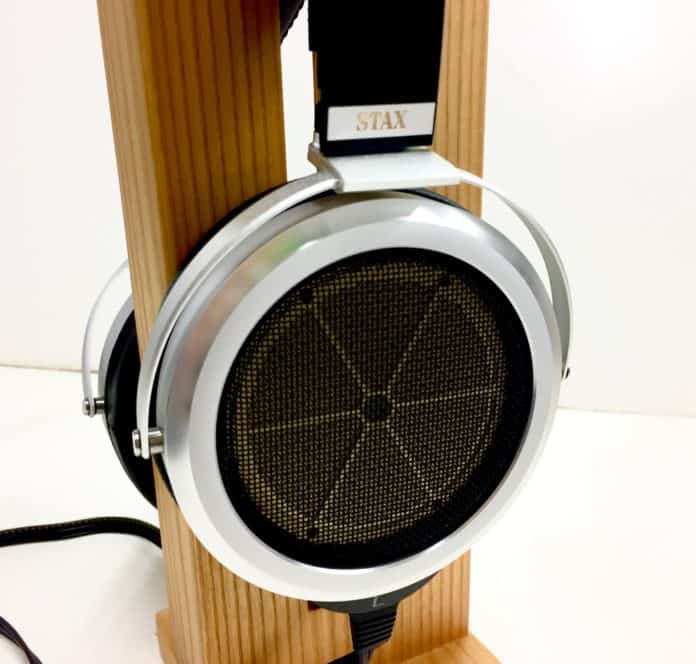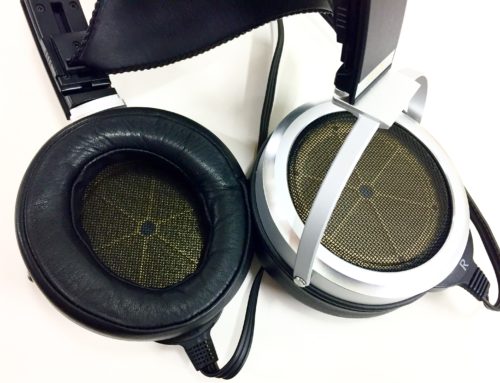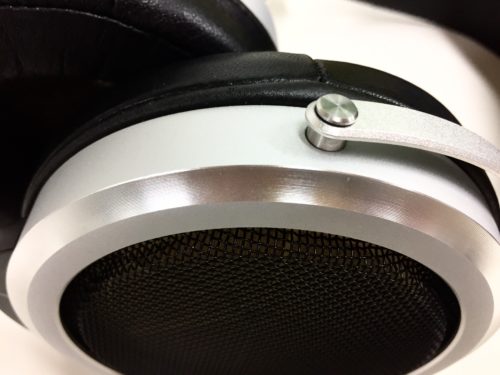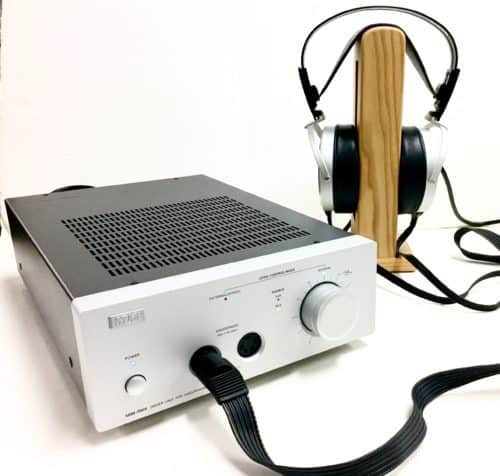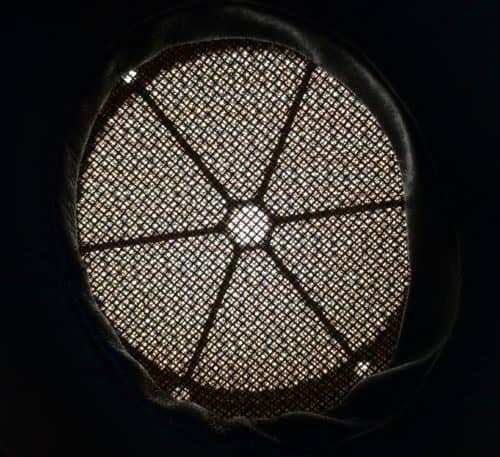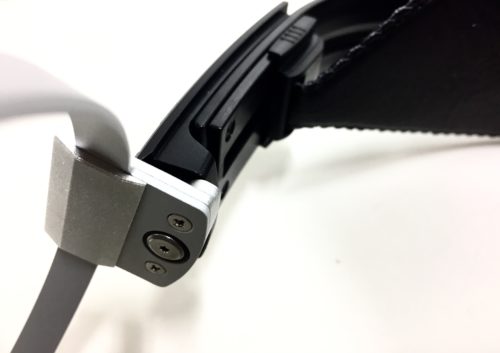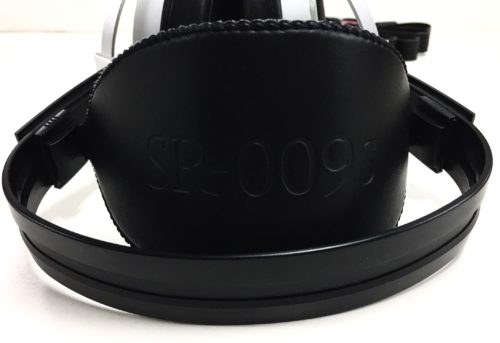Most audiophiles, I think, have an awareness of the headphone manufacturer Stax. But for those who don’t have an intimate familiarity, Stax is best-known as the original producer of electrostatic headphones – that is, headphones that use an extremely thin, electrically-charged membrane suspended between two “stators,” a grid of conductors that carry a high-voltage charge that moves the membrane. Electrostatic headphones have a reputation for being extremely detailed and extremely fast, possibly moreso than any other kind of headphone. Even today, electrostats enjoy the benefit of greater speed and lower distortion than all but the most premium dynamic and planar-magnetic headphones.
The current flagship of Stax’s lineup is the SR-009s, a slight revision of its previous flagship the SR-009. This revision brings changes in the stator design (they’re now gold-plated, one of the big obvious differences), as well as the earcup design. It’s also reputed to sound a bit warmer, with a big more emphasis on the lower midrange, which should be welcome news to those who found the SR-009 too thin-sounding. More info is available on the Stax website, of course.
The SR-009’s outsize reputation for clarity, speed and airiness made this a very anticipated review for me. Basically, I’ve been looking forward to reviewing these things forever. And now, after first hearing them at Canjam, I have them in the offices for review, so let’s get started!
Build, Appearance and Comfort
Stax has a reputation for pouring their entire budget into sound and very little into quality materials or build quality. (Notably, the the SR-L700 is made almost completely of plastic.) This is only a little bit true for the SR-009s.
Of course, it’s no Lambda. The design is both more conventionally attractive and more solid-feeling. The earcups are made out of precisely-machined aluminum, designed with an eye for detail. I particularly enjoy the little grooves along outside edges of the earcup. The SR-009s also comes with real leather pads, and they feel very premium, soft, and comfortable. Same goes for the leather head-strap (though I personally prefer the cloth headband that Stax used back in the 80s).
On the other hand, the SR-009s uses the same plastic headband as the SR-L700, something that provides unfortunately good cannon fodder for the Stax naysayers. The earcups also feel a little bit loose, and they tend to flop around a bit when the headphone isn’t on your head.
Is this all nitpicking? In my opinion, it is, especially given that the SR-009s is extremely comfortable. The headband gets the pressure just right – tight enough to avoid sliding around (which can be a problem with the Lambdas, especially the older ones, from time to time), but loose enough to avoid any discomfort at all.
And they look good, too. Stax used to hide the stators of their headphones behind a layer of foam, but I’m glad they’ve stopped – the gold-colored stators, with their hexagonal support structure, are extremely visually striking.
Sound
For more information on how I describe sound, check out my article “How Headphones Sound.”
The big advantage that Stax headphones provide is the way they present detail in a totally “effortless,” “smooth” way. People who’ve heard an electrostatic headphone for the first time will often comment that it’s like “there’s nothing between you and the music,” “it just feels like it materializes out of the air,” etc.
And a big part of that sound is low distortion and lightning-fast decay. When you’re using the SR-009s, there’s a very low chance that any grain or ringing you’re hearing is coming from the headphones – more likely, it’s a part of the recording.
On the other hand, the total lack of distortion can make the headphones sound like they lack “solidity” or “tactility,” a common criticism of Stax (and electrostats in general). Whether that impression is valid or not is up to you. I find it to be only partially true – for me, the Stax SR-009s is great at imitating the sound of a concert hall. For more intimate recordings, though, the sound can be a bit airy and diffuse, but more on that later.
(For the purposes of this review, I used the iFi Micro iDSD Black Label as a DAC, feeding the Stax SRM-700s amp.)
Bass
While the total lack of distortion makes for supreme clarity and definition, some find that it takes away a sense of “tactility” or “solidity” from the headphones. Nowhere in the frequency response spectrum is this more applicable than the bass region. Here, the SR-009s has been found by some to lack “slam.”
Well, it isn’t totally lacking, but when it comes to replicating the astonishing dynamics of a headphone like the Hifiman HE-6, the SR-009s isn’t quite up to par. If all you’re looking for is slam and dynamic ability, somewhat at the expense of clarity, there are planar magnetic headphones that may be more your speed.
However, the SR-009s provides predictably great bass resolution. The SR-009s provides THD well below 1% right down to 20Hz, so you’ll miss absolutely nothing happening in there. All textures will shine through. The SR-009s’s bass is very good, it just won’t provide the kind of visceral, skull-pounding attack that some other flagship-tier headphones are capable of.
Mids
In the midrange section, I usually find myself addressing issues of clarity and realism – how close to actual instruments does the SR-009s sound? A lot of that has to do with frequency response in the midrange.
Frequency response-wise, the SR-009s’s midrange is broadly neutral, with a few minor colorations present. Most notably, there’s a dip at around 2.5kHz – 3kHz, meaning the midrange sounds just a bit distant or thin – a boost in this region would result in a more “intimate,” “full-bodied” sound. Otherwise, the SR-009s’s mids are largely on the mark.
A Word on “Realism”
But with Stax in general, and especially the SR-009s, one finds oneself considering problems that are a bit larger than frequency response. That is, what exactly is “realism?” It’s true that a fast decay means that Stax’s headphones present the truest possible recreation of a recording, with some variations in frequency response. But some people prefer a slightly slower headphone, considering headphones like the Sennheiser HD600 more realistic. The timbre of the SR-009s is too light, too airy, some people say; “it sounds like you’re listening to toy instruments,” said one person I talked to.
It’s also worth mentioning that as far as I’ve been able to hear, electrostats tend to foreground issues with recordings, like resonances and distortion. As a result, any recording that’s been made with flawed equipment retains more of the characteristics of the equipment than the sound source. So there are times when it feels like I’m “listening to the recording” more than I’m “listening to the music.” But of course this is only an issue with bad recordings, and it’s hardly reasonable to blame Stax for that!
As a classical musician for most of my life, I can say that the SR-009s at least gives you a pretty damn close approximation of what it’s like to be in the audience at a concert hall. That’s not to say that the simulation is perfect; that’s impossible with headphones. But it gets me closer than pretty much any other pair of headphones I’ve tried.
Treble
The Stax SR-009s fares about how one would expect in the treble – extremely well. It’s absurdly fast and resolving, and it’ll give you pretty much all of the details of your music without compromise.
One might expect that extremely resolving treble would necessarily be harsher or less forgiving of bad recordings, but I find that this typically isn’t the case. Yes, the SR-009s will reveal low-quality recordings. But because there’s no ringing in the treble, recordings with pronounced treble will be less fatiguing than on less resolving headphones.
The result is that the treble of the SR-009s is both extremely resolving and extremely smooth. However, it’s not completely even in frequency response (very few headphones are), so you get a bit more upper treble than mid- and lower-treble.
Soundstage
The HD800s is still my benchmark for soundstage, and it doesn’t look like SR-009s will dethrone it, but that doesn’t mean it can’t take a nice comfy seat in the top 3 soundstaging headphones I’ve heard, right next to the Final D8000 Pro. One gets a very wide stereo image with pinpoint accuracy. The stage also has a great sense of depth and height.
The one shortcoming with the SR-009s is that it doesn’t do intimacy quite as well as some other headphones. Things that are supposed to sound distant sound distant; things that are supposed to sound immediate still sound just a tiny bit distant. Perhaps this is part of what people mean by “artificial.” Then again, many headphones that are great at intimacy fall flat in soundstage width for me – this is really a trade-off for any headphone, I think, not necessarily a flaw in and of itself.
Pros and Cons
Pros: Ridiculous resolution; wide soundstage with good imaging; smooth presentation; well-balanced sound; looks great; very comfortable
Cons: Not great for intimate or aggressive recordings; upper midrange a bit thin; unforgiving of production errors
In Conclusion
It probably seems like I’ve leveled a lot of criticisms at the Stax SR-009s. Luckily, I have this conclusion section to sort things out. The Stax SR-009s is one of the best headphones I’ve heard. Its airy, ethereal presentation of sounds is unlike anything else out there, and it’s absurdly good for classical, ambient, and any other genre that demands a wide, well-separated sound.
Of course, that airy sound can turn from a strength to a weakness when it comes to rock, metal, and other genres that demand an energetic, in-your-face sound. Those whose libraries consist primarily of classic rock, for example, may want to look at other options for the pure enjoyment factor. (That said, I’ll add that the totally uncompromising insight into your music of which the SR-009s is capable is an enlightening and enjoyable experience in and of itself.)
But of course, even if the SR-009s doesn’t sound quite up your alley, it (or its sibling, the SR-009) is still one of the absolute “must-try” headphones of audiophilia. Its polarizing reputation only proves that it boasts the absolute performance to attract a reputation in the first place. So do try the SR-009s if you’re given a chance.
And if you’re interested in purchasing, check it out at Audio46.
Specifications
| Specification | Stax SR-009s |
|---|---|
| Electrostatic capacitance | 110pF (including cable) |
| Impedance | 145 kOhm (including cable, at 10kHz) |
| Maximum sound pressure | 118dB / 400Hz |
| Bias voltage | 580V DC |
| Weight | 1lb without cable / 1.3lb with cable |
As a disclaimer, MajorHifi may receive commissions from retail offers.
Compare the ranking of various headphones, earbuds and in-ear monitors using our tools.
Discuss this, and much more, over on our forum.
---MAJORHIFI may receive commissions from retail offers.


